Introduction:
In researching the brewer Frank Jones for a history of his brewery I found that there was a ship named after him that traveled along the Maine coast as well as on the Long Island Sound routes. I began collecting information on the steamship Frank Jones and discovered a fascinating history of coastal steamships in the late 19th and early 20th century. The Frank Jones wasn't the most notable ship plying these routes, but it's the only one I have found so far named after a brewer.
 |
The Frank Jones. From a 1905 postcard. (photo from author's collection)
Unless otherwise noted, all the material on this page came from the books of Edwin L. Dunbaugh. Graphics are from my own collection.
Launched in 1892, the Frank Jones served along the Maine coast. At first it was owned by the Boston and Main Railroad, which in turn was owned by the brewer Frank Jones. The steamer Frank Jones traveled from Portland to Rockland, then to Bar Harbor and Machiasport. It replaced the venerable City of Richmond, which had been built in 1865 and rebuilt in 1881. The Frank Jones was an elegant looking ship. It had a wood hull (painted mostly white judging from photos), an inclined engine, feathering side wheels and a single raked smokestack so it looked sleek and modern. However, the ship developed a reputation for being hard to steer, with a tendency to roll, and it was especially difficult to handle in rough seas.
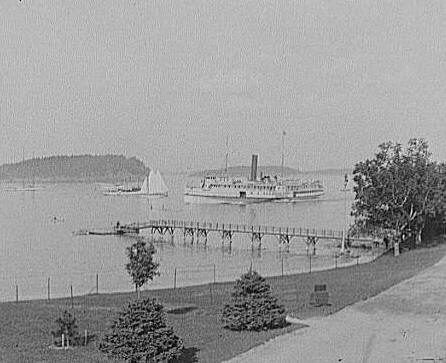 |
The Frank Jones in Bar Harbor, Maine. circa 1901. From the Library of Congress.
The Frank Jones stayed on the Maine coastal route from 1892 through 1904. Newspaper ads show that its schedule changed over the years, which was normal as companies went into and out of business, new ships were launched and old ones were retired. An 1896 advertisement showed that the Frank Jones was sailing a route between Castine, Bar Harbor and Machiasport for the Maine Central Railroad. In 1897 its route went between Portland, Bar Harbor and Machiasport as part of the Portland, Mt. Desert and Machiasport Steamboat Company, which may itself have been owned by the Maine Central Railroad. Typically the Frank Jones' trips would take two days; leaving Portland late in the evening Tuesdays and Fridays, and sailing from Machiasport very early (4 am) Mondays and Thursday back to Portland, arriving about 11 pm.
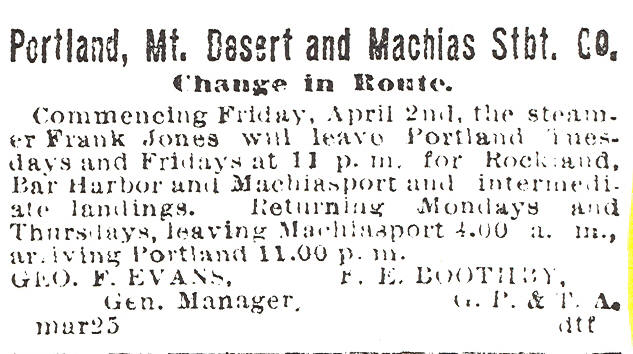 |
A newspaper advertisement for the Frank Jones, The Portland Eastern Argus, April 7, 1907.
The Frank Jones sailed along the coast for 13 years. In 1905 it was sold to a shipping line that serviced the Long Island Sound trade, the Enterprise Line. The Frank Jones would sail the New York City-Fall River Massachusetts route in competition with several other lines owned by railroad interests with larger, more luxurious ships. The Fall River route was the setting for a long battle between large and small companies competing with each other, often on behalf of competing New England railroads, particularly the New York, New Haven and Hartford. The New Haven was controlled by J.P. Morgan. In 1904 it had fully established a virtual monopoly over control of the railway systems of New England. Charles Mellen became company President and along with Morgan he was determined to drive any steamship line that competed with their business into bankruptcy.
The Long Island Sound steamships carried passengers and cargo between not only New York City and Fall River, but between New York and Providence, Hartford, and New London. Fares usually ranged from 75 cents to three collars in the first years of the twentieth century. The Fall River route was especially popular because it was a convenient way to travel between New York City and Boston as a traveler could transfer to a train in Fall River for a quick trip north. For example, a businessman taking a trip to Boston could buy a ticket for $3.00 or under and board an overnight steamer in the later afternoon at its pier on the East River in lower Manhattan. About 6 pm the ship would pull away from the dock and head towards Long Island Sound. The passengers could enjoy a nice dinner in the dining room and watch the harbor and other ships, or sit and relax on the deck. Staterooms were normally very small because they only had to be big enough for changing clothes and sleeping. Except for a few first class cabins on the larger ships, your bathroom was a shared facility down the hall. If the sea was quiet it would be a smooth ride as the Long Island Sound was sheltered from the Atlantic by Long Island. Unless there was fog--making it necessary to blow a foghorn regularly-- you could fall sleep to the sounds of the engine and the paddlewheels turning in the water. Getting up at 5 am you'd have time to wash up, get dressed, maybe grab some breakfast, then catch a train from the docks at Fall River to be in Boston in time for the opening of the business day. It was a (relatively) inexpensive and fast way to travel between the two big cities of the northeastern U.S., especially as the big steamships seemed to have a better safety record at the time than did some of the railroads.
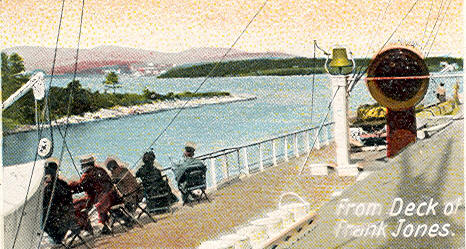 |
From a 1905 postcard. (photo from author's collection) Expanded several times the original size.
In 1905 one of the main independent steamship lines in the Long Island Sound was the Joy Line. Founded in 1899, it was named after one of its founders, Allan Joy. It had been established to compete with the New Haven Railroad on the New York Providence route. In response, the New Haven created the Fall River Line. The Joy Line continued to operate in the face of opposition, servicing customers who either could not afford the higher rates of the other lines.
In the Spring of 1905 the Joy Line and the railroad lines had a new competitor, the Enterprise Line (also called the New Line). Like the Joy Line, the Enterprise Line was a low priced carrier. Owner David Whitcomb had purchased a Maine coastal shipping line that had gone out of business. At first it had only one vessel, the Frank Jones . Smaller than most of the ships on the railroads' steamer lines, the Frank Jones sailed from New York to Fall River on Mondays, Wednesdays and Fridays, and from Fall River to New York on Tuesdays, Thursdays and Saturdays. Rates for passage were set at one dollar on the Frank Jones, vs. the normal rate of three dollars on the more expensive lines. Freight rates were equally low.
Charles Mellen came up with a two part plan to drive the Enterprise Line out of business. The New Haven Railroad spun off yet another competitor shipping line, the New England Navigation Company. This new company would run large freight steamers to take business from the Enterprise Line, which could not survive on passenger fares alone. Mellen also decided to buy the Joy Line in order to compete with the Enterprise Line for low fare passengers. The Joy Line was purchased by the New Haven in December 1905. For its part, the Enterprise Line added another steamer, the Kennebec, to complement with the Frank Jones.
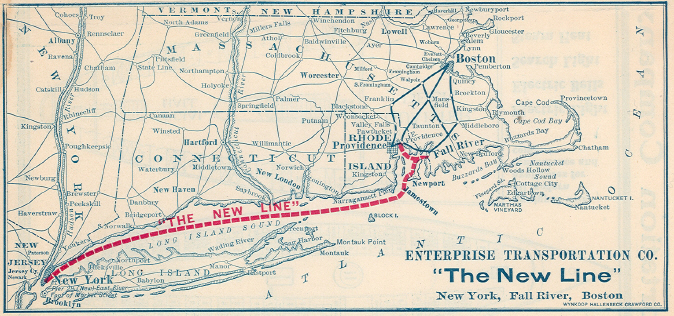 |
The New Line's Route, from a 1907 company pamphlet. |
Meanwhile, the New Haven railroad was also expanding. After acquiring the Joy Line, the New Haven Railroad then set up yet another low cost shipping line, the Neptune. They also purchased several other lines which operated between New York and Maine to reduce any further competition. By 1907 the New Haven was operating, through its shipping companies, the six largest and most opulent steam ships between Fall River and New York, all competing with the tiny (by comparison)New Lines with its two ships, the Frank Jones and Kennebec.
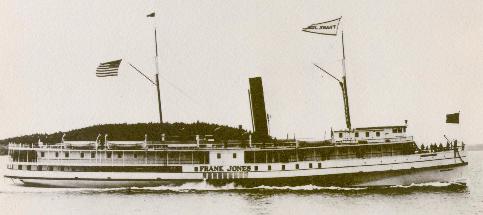 |
The Frank Jones. date unknown. (photo from author's collection)
In the Fall of 1907 Maine steamboat line owner Charles W. Morse began to run into legal problems. Morse had made a fortune selling Maine ice in New York City, and then expanded into shipping and banking. He had used his banking interests to make illegal loans to his shipping companies and had falsified bank records to hide his activities. At the same time Morse's legal and financial problems began the Enterprise Line found itself unable to meet its financial obligations. The supposedly independent company had been financed in secret by Morse in his business struggles against the New Haven and its owner, J.P. Morgan.
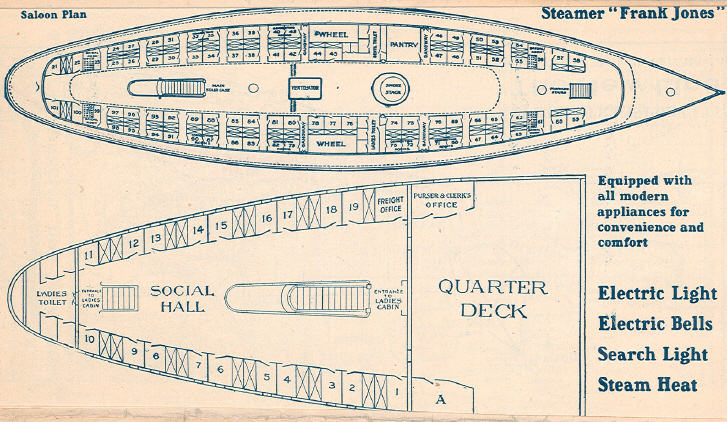 |
The deck plan of the Frank Jones, c. 1907 (click to see larger) |
The Frank Jones was undergoing repairs when Morse found himself unable to continue funneling money to the Enterprise Line. The ship had been rebuilt in the Winter of 1906-1907. As a result the Enterprise Line closed at the end of 1907 and its creditors seized possession of the Frank Jones . The ship sat in its Brooklyn shipyard, its $60,000 repair bill unpaid.
In the Summer of 1908 the Frank Jones was purchased by the New Hudson Line to carry passengers between New York City and Albany. Its partner ship was the Saratoga. Once again the Frank Jones was being used by a low fare independent shipping line. The New Hudson Line closed after 1908. In July 1909 the Frank Jones and the Saratoga were sold to the Manhattan line, also a discount carrier running between New York City and Albany.
It was during this period that the Frank Jones took part in the 1909 Hudson-Fulton Celebration. Arranged to celebrate the 100th anniversary of the invention of the steamboat in 1807 as well as the three hundredth anniversary of the discovery of the Hudson River by Henry Hudson. The activities included a regatta up the Hudson River with craft from around the world accompanying a replica of Robert Fulton's Clermont. The Frank Jones was one of the many passenger steamers present, along with ships from the various rival shipping lines from the Long Island Sound routes.
After the 1910 season the Frank Jones was sold to the Capital City Line, also sailing between New York and Albany. This was the Frank Jones' last stop as a passenger steamer, sailing in competition with the Manhattan Line from 1911-1915. At the end of 1915 the Frank Jones had its named changed to the Fenimore and it was placed in mothballs, awaiting a buyer. In April 1918 it was requisitioned by the U.S. Navy to carry naval stores during the First World War. On June 22, while carrying supplies and ammunition, the Frank Jones/Fenimore caught fire on the York River near York, Virginia. The ship burned and the ammunition exploded destroying the old steamer.
As far as I know its remains are still at the bottom of the York River. I'd like to find out more about its end, so if you have any information please email me at Mark@rustycans.com
Corrections and additions are always welcome.
 |
The Frank Jones. date unknown. (photo from author's collection)
The SS. Frank Jones 1892-1918The Frank Jones was built in 1892 at the Bath Iron Works in Bath, Maine. The following stats for the Frank Jones comes from the Bath Iron Works site. Passenger Steamer for the Portland & Machias Co. Launched March 26,1892, delivered August 9,1892. |
Sources
 |
For more information on steamships, contact the Steamship Historical Society of America . (I am now member 10052.)
Unless otherwise noted, all the material on this page came from three books by Edwin L. Dunbaugh. All graphics are from my own collection.
The New England Steamship Company (University Press of Florida, 2005)
Night Boat to New England: 1815-1900 (Greenwood Press, 1992)
The Era of the Joy Line (Greenwood Press, 1982)
